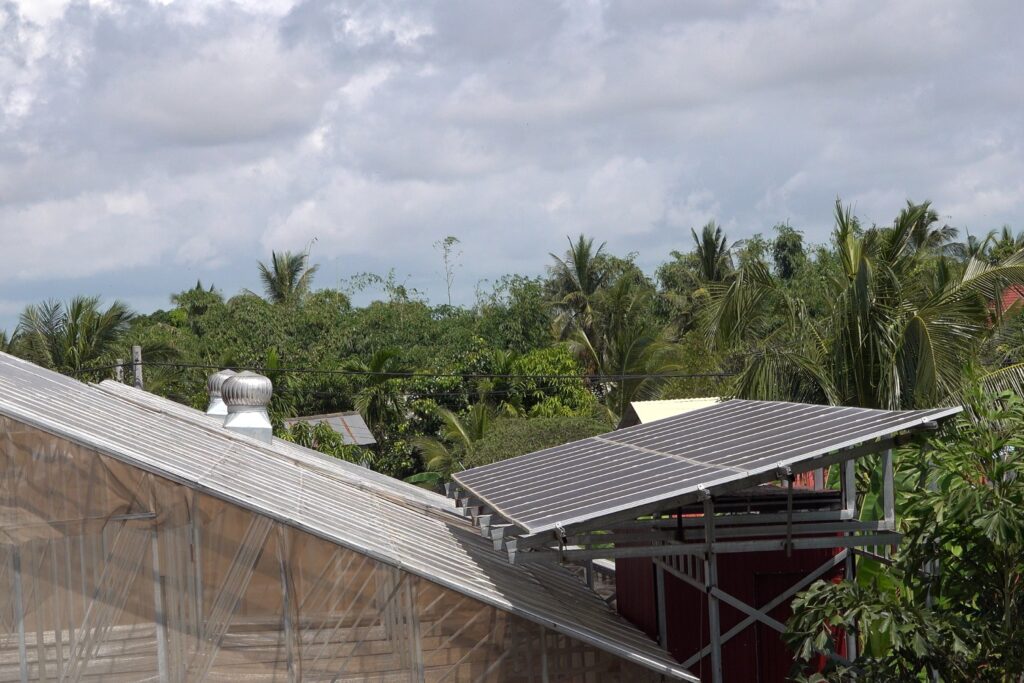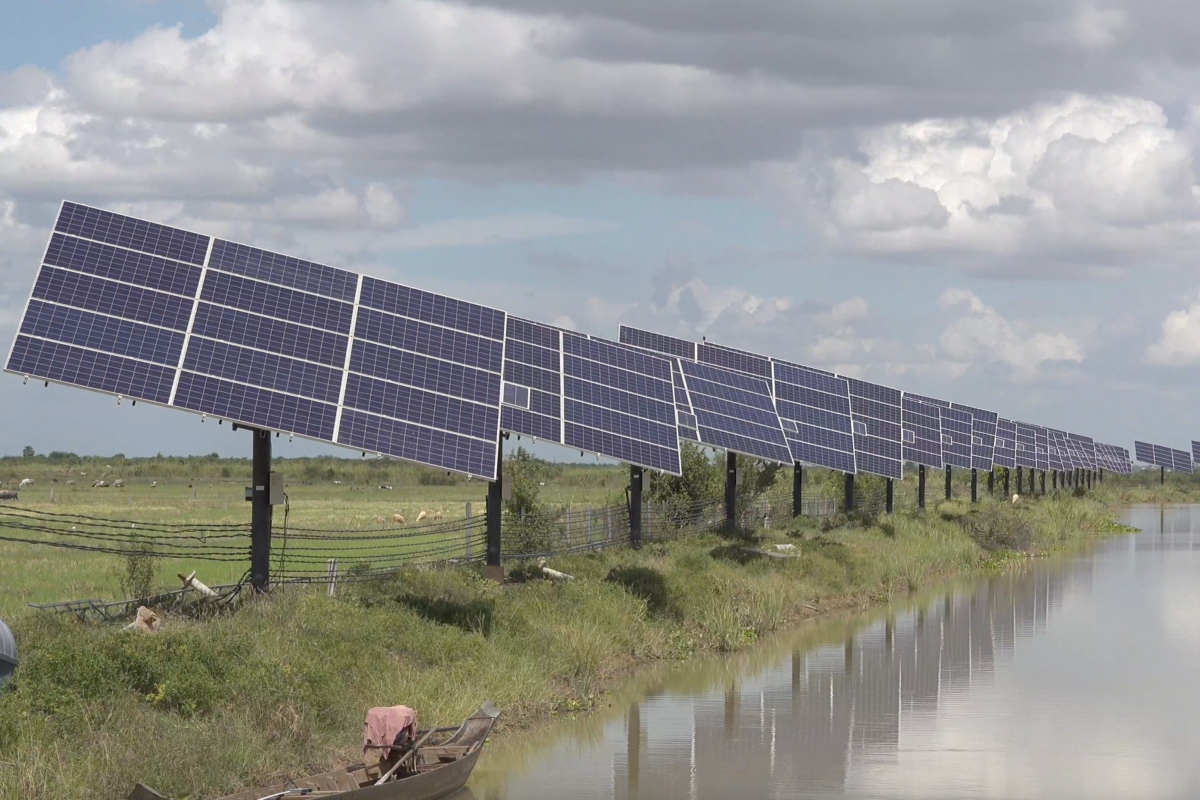SIEM REAP, CAMBODIA – A bottom-up energy transition is happening in Cambodia where farmers and business owners in rural areas have adopted solar power to improve their productivity and incomes.
But a stronger policy push from the government is needed to tap into the country’s high solar potential.
The plants grown in Rom Sary’s hydroponic farm in Aranya village in Siem Reap province have never suffered from heat stress since he installed solar panels two years ago.
Set in a 368-square-meter greenhouse, his farm requires electricity from 4am to 8pm to power fans that cool the place and to run the water systems that feed nutrition to the plants.

“I used on-grid electricity when I started growing vegetables and experienced frequent power outages that jeopardized my plants,” said the 28-year-old farmer. “Solar power helps us avoid the losses and secures profits.”
Shifting to solar power has reduced his electricity bill by 10 times. He now spends about US$50 a month on electricity from the national grid. The rest of his electricity needs are powered by his solar panels.
Farmers like Sary are some of the main beneficiaries of small-scale solar power initiatives that are mushrooming in Cambodia’s rural areas – driven by farmers’ demand for energy and startups and non-governmental organizations that take a bottom-up approach to accelerating the energy transition.
Dam Sosrei Neang, the field manager of local startup Solar Green Energy Cambodia, said farmers make up the largest share of his company’s customers. Cost saving and productivity increases are the reasons farmers are attracted to the company’s solar power products and installation services.


“Solar energy has become the primary solution that provides basic needs for rural households off the grid,” said Out Sokphalkun, the Program Manager of EnergyLab Cambodia, a non-profit organization supporting the growth of the clean energy market.
“Those needs include running water pumps, processing food and storing agricultural products.”
EnergyLab has implemented its SWITCH To Solar program, which supports Cambodian entrepreneurs and startups and promotes solar power in the agriculture and fishery sectors and connects them to farmers and rural businesses.
The program supported solar companies that sold products worth more than $1.4 million and promoted solar technologies to more than 3,000 micro, small and medium-sized enterprises.
Many other grassroots solar projects have sprung up and helped move Cambodia’s energy transition forward. However, maximizing the use of clean energy will require more policy changes.
Robust solar energy
The economic and environmental benefits of solar energy have been recognized in Cambodia since the government pushed for the first utility-scale solar power plant near the country’s eastern border in October 2017.
The 2019 UNDP report on Cambodia’s solar potential indicates that its year-round sunshine offers a great opportunity to tap into more energy, with the daily amount of solar energy equivalent to five kilowatt hours per square meter – which is considered “very robust.”
EnergyLab’s study found the capital and operating costs of solar energy have already become the cheapest among the other sources of energy in Cambodia. The price of electricity produced from solar energy is about three cents per kilowatt, much lower than coal, which requires 7.7 cents per kilowatt.
Despite this untapped potential, the share of solar power in Cambodia’s energy mix is still small, accounting for 7% of electricity generation in 2021. The country relies on hydropower/marine and fossil fuels, which account for 52% and 41% of total capacity, respectively.
The heavy reliance on hydropower has caused power outages in every dry season when water levels in rivers and reservoirs are low.
To ensure energy security, Cambodia plans to increase its share of renewables in its energy mix to 20% by 2030, while reducing its reliance on hydropower. Solar power is expected to be 18% of the energy mix.

Heng Kunleang, the Director General of the Department of Energy, Ministry of Mines and Energy, said the government was willing to maximize solar energy in the long run “without compromising the stability of the national electricity supply.”
The government has introduced the Rural Electrification Fund, which provides financial support to more than 22,645 rural households, the equivalent of 104,167 people, to install home solar systems.
The longer-term solution will require more incentives and investment that utilize more solar power projects that can help the country achieve an energy transition.
Couldn’t wait any longer
In June, Cambodia’s Ministry of Mines and Energy issued new “2023 Solar Guidelines” that aim to push for more adoption of solar energy, especially solar rooftops.
According to an analysis from law firm Tilleke & Gibbins, the guidelines provide principles for approved rooftop solar projects to feed excess power into the national grid.
The government also included references to solar and renewable energy in the Environment and Natural Resources Code, stating that relevant authorities must establish a pilot renewable project for a preferential tariff system – which will likely lead to the development of a feed-in tariff in the future.
“We expect that these principles and guidelines will eventually lead to clear rights and obligations as they are implemented through legislation and official policy in the coming years,” summarized Tilleke & Gibbins’ analysis.
Sokphalkun from EnergyLab suggested the government initiate policies that encourage individuals and industries to use solar power. Those policies include providing low-interest loans or subsidies for households and businesses to install solar panels.
On the other hand, farmer Rom Sary urged the government to subsidize batteries that can help households and rural businesses store solar power for 24-hour usage. The high cost of batteries makes them unaffordable for many subsistence farmers, who make up most of the rural population in Cambodia.
While the state actors are working on policies to accelerate solar energy, 42-year-old pig farmer Thoeun Theavy from Sbay Preal village in Kampong Speu province could not wait any longer.

She decided to invest in solar energy out of her own pocket three years ago as she struggled to meet rising energy costs. Thanks to solar power, she now pays half of the $4,000 monthly electricity bill that covered gasoline for generators and electricity from the grid.
“In the dry season, we had to spend a lot on electricity to keep our fans running on the farm,” she said. “I had to pay the bills every month and I couldn’t avoid it.”
This story was produced with support from the Internews’ Earth Journalism Network under the Our Mekong, Our Say project funded by USAID Mekong For the Future. It was first published in the Voice of America Khmer and edited by Mekong Eye’s editorial team for clarity.





